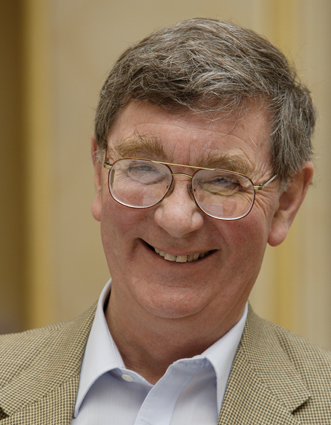
Dr. Peter Ford
Structural Material Degradation
BIOGRAPHY
Dr. Peter Ford received his bachelors and doctoral degrees from Cambridge University (UK) and a masters degree from RPI (USA), with an emphasis on metallurgical engineering and corrosion science. Initially he “learned the trade” in the 1960s when he was as an engineering apprentice for a turbine manufacturer and an alloy developer for the Olin Corporation in the USA. Since then he has been associated with the nuclear power industry, with a focus on developing mitigation actions for various modes of environmentally-assisted degradation of structural materials.
He worked initially as manager of the corrosion group at the research laboratory of the Central Electricity Generating Board (UK) and then for 23 years with the General Electric Corporate Research and Development Centre (GE-CRD) (Now the GE Global Research Centre) where he was manager of the Corrosion Mitigation and Coatings Laboratory. This laboratory interacted closely with General Electric Nuclear Energy and their customers in the USA, Asia and Europe resolving issues with Boiling Water Reactors.
Seminal contributions were made in the areas of:
- Choice of structural materials for current and future reactors to minimize environmentally-assisted degradation
- Optimized fuel cladding compositions to counteract nodular oxidation
- Radioactivity build-up control via zinc injection
- Life prediction codes for environmentally-assisted cracking of materials both in and out of the reactor core. This mechanistically-based methodology provided the fundamental basis for water chemistry specifications for BWRs used world-wide Water chemistry optimization methods for mitigating environmentally-assisted cracking, including “Hydrogen Water Chemistry” and
- “Noble Metal Technology”
- Underwater repair and cladding techniques
Upon retirement from GE in 2000, he served at the US Nuclear Regulatory Commission for 4 years as a member of the Advisory Committee for Reactor Safeguards addressing issues ranging from materials degradation, new reactor design certification, license renewal, etc. for all light water reactor designs. He became associated with ANT-International in 2005. Dr. Ford is active in various societies and international cooperative groups in the field of nuclear materials degradation, including consultancies with reactor vendors, utilities, universities and national labs, etc. He has authored or co-authored 100 papers, handbooks and patents and is a Fellow and recipient the Willis Rodney Whitney Award from NACE-International for “outstanding contributions to the science of corrosion”, and specifically, predicting environmentally assisted cracking in BWRs.
How did you get started as an engineer?
I started my career as an engineering apprentice for a UK turbine manufacturer in 1958, and from that early experience I developed an interest in materials performance. This led to my going to Cambridge University where I was awarded my bachelors’ and doctoral degrees, with the latter concentrating on stress corrosion cracking and corrosion fatigue.
Your career history?
After receiving my PhD I joined the Central Research Laboratories of the (former) CEGB in the UK working mainly on corrosion problems in steam turbines and the SGHWR. In 1977 my wife and I returned to the USA where, for 24 years, I managed the Corrosion Group at the GE Corporate Research and Development Center. Apart from activities associated with gas turbines, steam turbines, chemical plant, etc., the main research activities, related to environmentally assisted degradation problems in BWRs. From this research evolved such processes as GEZIP, noble metal technology, life prediction methodologies for environmentally-assisted cracking, monitoring systems, etc. Upon retiring in 2000 I was a member for four years of the Advisory Committee on Reactor Safeguards to the USNRC Commissioners.
How did you get introduced to ANT International and the LCC Programme?
Al Strasser approached me at a conference in 2005 and, following discussions with Peter Rudling, I joined the LCC team in 2006.
How has the field of material integrity issues changed during your career?
Environmentally-assisted material degradation has largely been managed in a reactive manner and this has led to less-than-optimum mitigation actions because of both a limited development time and the inadequacy of many of the laboratory testing procedures. As a result there is now a determined development of proactive management approaches, such that controlled mitigation actions are developed before the degradation has unacceptable economic and safety consequences. Such proactive management approaches have been made feasible by the development of qualified life prediction methodologies and extremely sensitive materials characterisation and damage accumulation techniques.
What do you forsee for the future in the nuclear industry, and how does the LCC Programme fit in?
There is no question that there is a resurgence of nuclear power in the Far East, and this is also very likely to occur in the US following the Energy Policy Act passed in 2005. The new reactors in the near term will likely be evolutionary designs (e.g. EPR, AP-1000, ACR-700, ESBWR) of the current water-cooled models, but after 2025 an increasing number may have considerably different design principles (i.e. the so-called GEN IV designs). All of these designs present significant materials–degradation challenges if the business expectation of “no materials failures” is to be met. A critical need in this resurgence is designers, engineers and researchers (both experimental and analytical) who have the necessary knowledge of materials-degradation modes. The output from the LCC program supplies the necessary education for this population.
How do you spend your leisure time?
Sailing in the summer, cross country skiing in the winter, travelling, reading and gardening (or at least digging where my wife tells me to).

